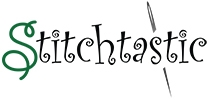Using waste canvas is not difficult if you are an experienced cross stitcher and it will enable you to create a truly unique finish to a plain article of clothing. Items such as t-shirts, sweatshirts, a pocket on a jacket or a plain canvas bag can be made to look really chic. The key to successful usage of waste canvas depends on the stitcher's ability to be creative. Waste canvas is relatively inexpensive to buy so do purchase more than you need as this will assist you when removing the threads, hence the name waste canvas.
When using waste canvas you will notice it is much stiffer than normal cloth used for cross stitch because it is starched. The canvas is available in four different thread per inch sizes - 8.5, 10, 14 and 18. Occasionally, waste canvas is woven with a blue thread every ten holes which assists counting whilst stitching. Some people tend to use an interface between the article and the waste canvas - this is purely a matter of individual choice but in this article, we're not including interface.
Once you have decided which item you are going to be working on, it is recommended that you wash it before you start stitching as some items tend to shrink the first time they are washed. Hopefully, this will also stop dark colours from running when stitching is finished.
Having chosen the design you wish to stitch, make sure the waste canvas is larger than the actual design as this will make it easier for you to remove the canvas threads when you have finished stitching. Now you must decide exactly where on your article you wish to place your design - in the centre of the item or possibly to one side? Wherever you decide to put it, as with all cross stitch pieces you commence stitching in the centre of the design. Place the waste canvas on your article in the position the finished design should be. Before you commence your actual stitching the canvas needs to be attached to the article. The easiest way to do this is to hand sew firm, small tacking stitches - do not just pin the waste canvas onto the material, it must be properly attached to avoid it slipping or moving whilst you are stitching. It is purely a matter of choice how you hand sew the canvas to the material, some stitchers sew from one side to the other whilst others stitch a few holes from the centre to the edge.
As far as using your usual hoop or frame to stitch is concerned, again this is a matter of choice but do remember some items of knitwear can easily stretch so a hoop isn't always the best method. It is necessary to use a needle with a sharp point as it might be difficult to push a tapestry needle through both the canvas and the material on which you are working. Not only that, the starch on the canvas occasionally blocks the holes and this is another reason a sharp needle is required.
When stitching these designs, regular colourfast thread such as Anchor or DMC is recommended as the finished article will eventually be washed several times and you do not want the thread to run. Some experienced stitchers prefer to "set" the thread prior to use especially if the design has lots of dark colours in it, and this is done by soaking it in three parts of water to one part of white vinegar. Following soaking, rinse the thread thoroughly until the water runs clear. The amount of thread used is determined by the size of the stitches and the amount of coverage required. A guide is 6 strands on 8.5-10 count waste canvas and 2-3 strands on 14-18. In any event, the thread should be stripped before use as this helps to avoid twisting, allows the thread to lie flatter, improves coverage and appearance.
When stitching, remember the article may be washed many times. To avoid the stitching becoming loose, the loop method of beginning stitching is recommended. To change colour or complete a row, run the needle under the stitches on the back several times to keep them secure. Be careful not to stitch through the waste canvas thread as this will make it practically impossible to remove later.
Having completed your stitching the last step is to remove the waste canvas. As it is very stiff, the easiest way to soften it is to dampen it using a spray bottle. Whilst damp, remove your original tacking stitches and using a pair of tweezers pull out the threads of the waste canvas.
You now have a unique attractive item of clothing and the satisfaction of knowing it is all your own work!
You can purchase waste canvas from our site here.
